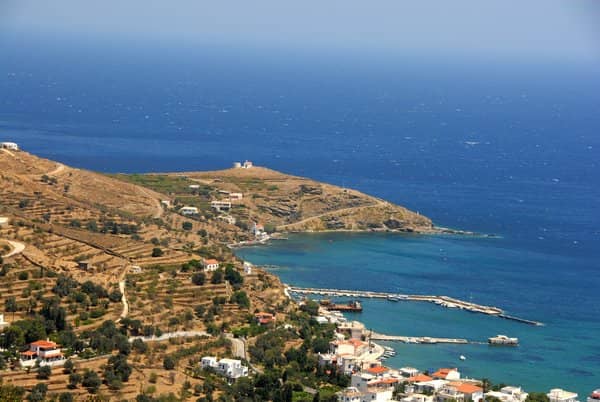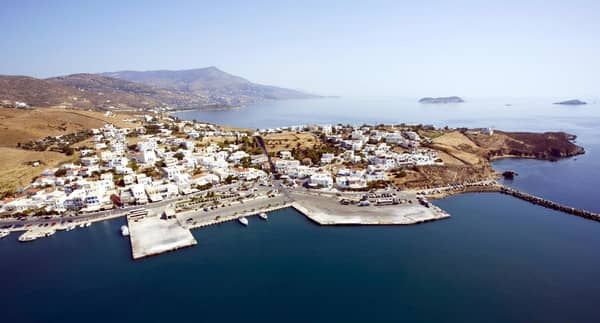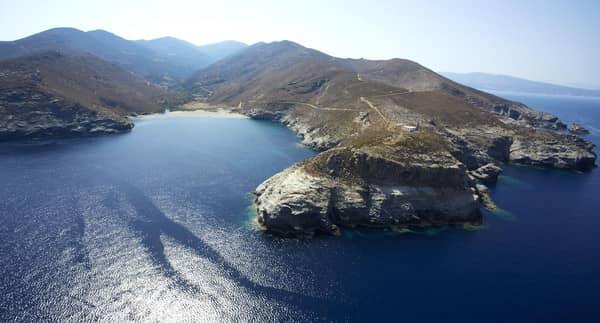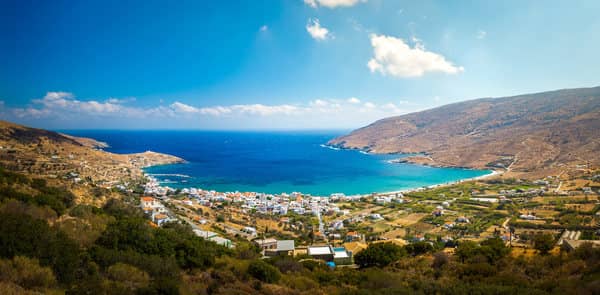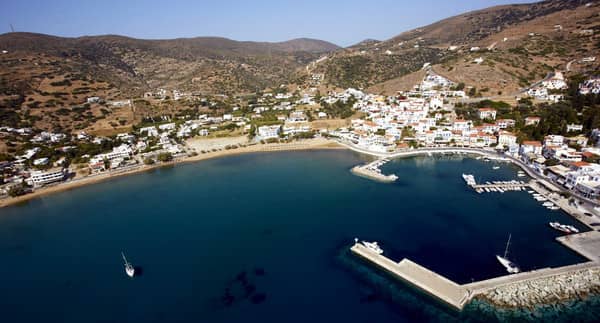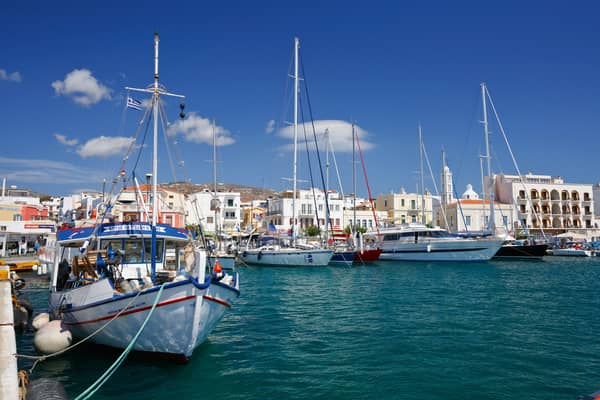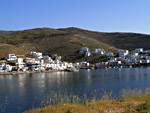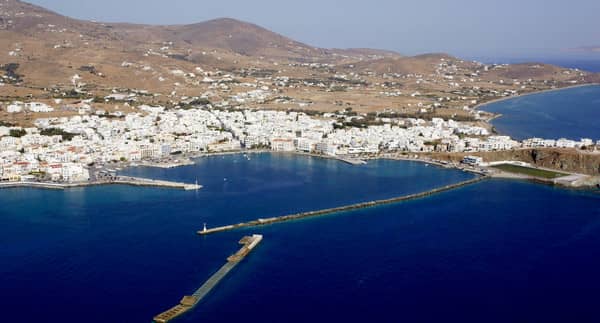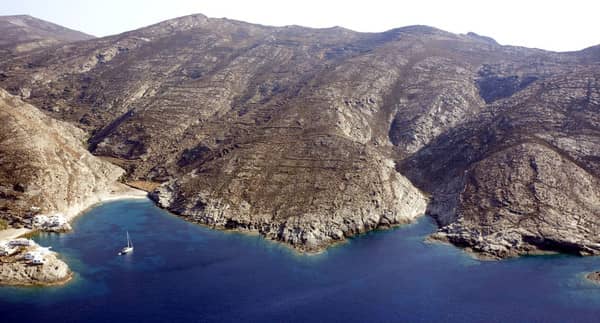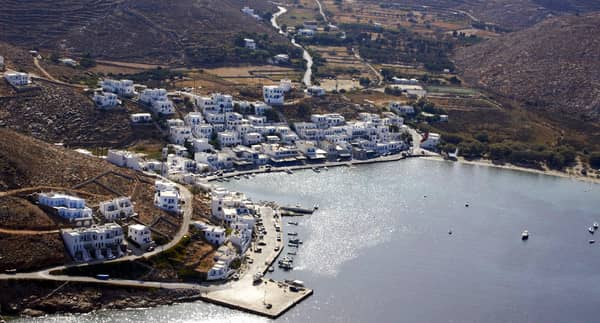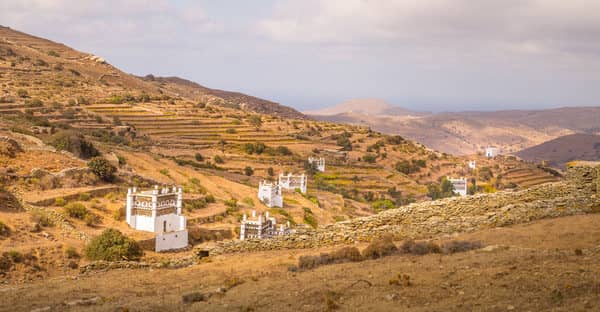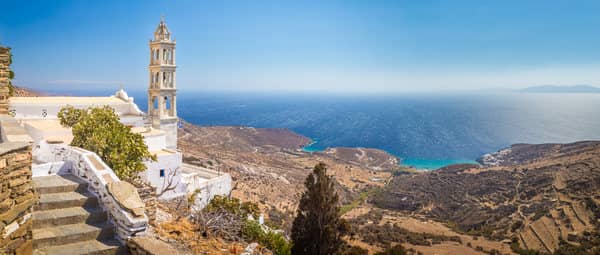Tinos & Andros sailing holidays
Andros island
The thickly wooded island of Andros - Άνδρος, the most northerly and, after Naxos, the largest of the Cyclades, is a kind of south-easterly continuation of Evvia, from which it is separated by a busy and sometimes stormy channel only 8 NM wide.
In the island's four ranges of hills, the largest of which is Mount Petalon (997 m), are marble quarries which were already being worked in antiquity.
Thanks to its unusual abundance of water Andros – most Cycladic islands are rather barren – has a flourishing agriculture.
History of Andros
In antiquity Andros was sacred to Dionysos, and its festivals in his honour were widely famed. Originally settled by Ionians, Andros came under the control of Eretria at an early stage.
In the 7th c. BCE it sent settlers to Chalkidiki. After the Battle of Salamis, when it had supported the Persians, it was unsuccessfully besieged by Themistokles. Later it became an ally of Athens; then in 338 BCE it fell into the hands of the Macedonians, and thereafter became Roman.
From 1207 Andros was ruled by Venetian dynasts, who built the watch-towers still to be seen on the island.
At the beginning of the 15th c. Albanian incomers settled in the north of the island, preserving their language into the 20th c. In 1566 Andros was occupied by the Turks, and remained in Turkish hands until the establishment of the Greek State in the 19th c.
Ports & anchorages
Andros island
Clockwise ↻
Tinos island
Clockwise ↻
Yiaros / Gyaros island
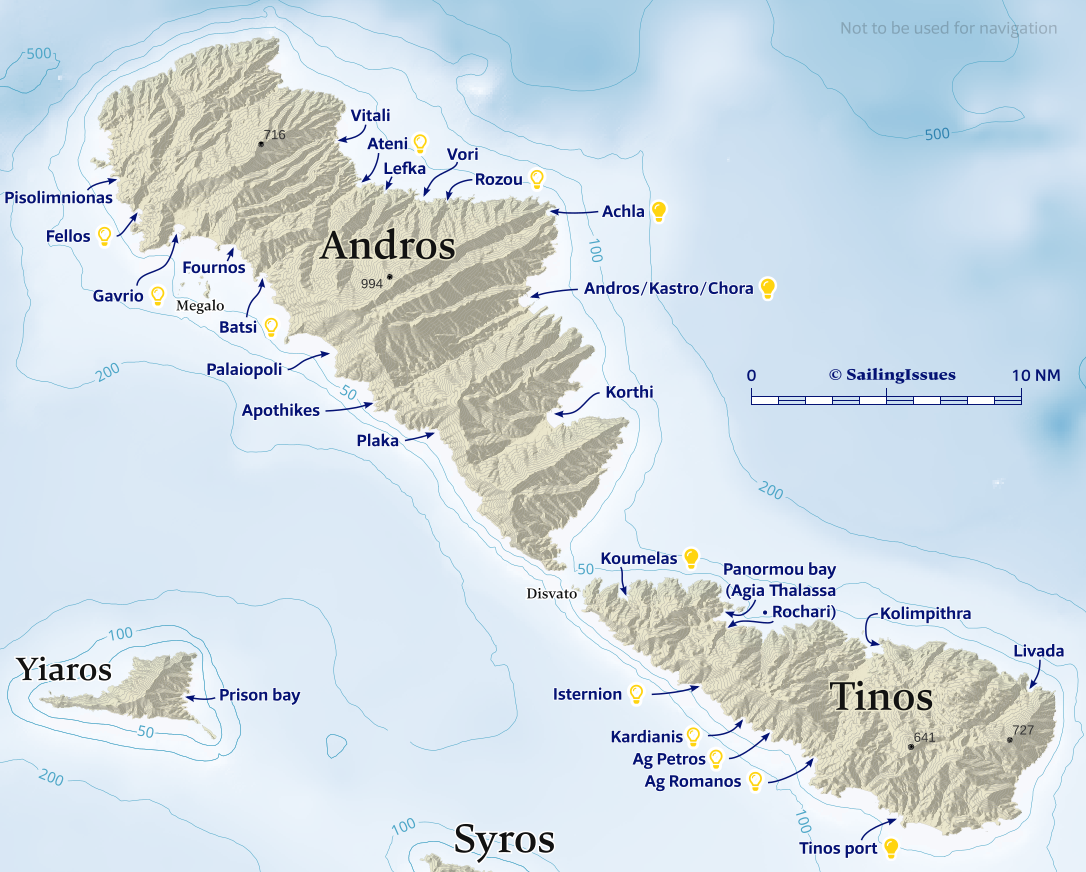
Ports / anchorages are clickable . signifies a highly recommended venue, and a truly must-see venue; see other icons.
Andros island ports & anchorages
Gavrio
The port of Gávrio - Γαύριο has a demanding approach – reefs, islets and rocks – but once inside it provides safety except during the strongest southerlies (waves and swell).
Ask the harbour master for a berth, which will be between the two ferry piers, so lots of scary close-ups of liners and wash from their wakes.
Early in season there can be strong north-west gusts, in the summer months north-east gusts.
Despite the many ferry visitors (including Atheneans) from the mainland, the place has its appeal and it is a convenient place to leave the yacht safely unattended and explore the gorgeous inland with many interesting villages!
Fellos
Fellós - Φελλός bay is a delightful anchorage Lat Long just north of Gavrio which offers clear blue waters and a taverna “Το Στεκι Του Ανδρεα“ 200 m inland. Safe in all but south-westerlies.
Andro– Andr–
The prefix andr– (or andro–, used before vowels), from Ancient Greek ἀνδρός (andrós), means “man” or “male”, read on…
Pisolimnionas
Pisolimniónas - Πισωλιμνιώνας is a useful bay on the westernmost coast of Andros island Lat Long; solid holding in sand and weed; open to S – NW winds.
There is extensive pisciculture in next bay to the north!
North anchorages on the east coast
Vitali • Ateni • Lefka / Levka • Vori • Rozou
- Vitáli - Βιτάλι ; vulnerable to NNE – SSE Lat Long
- Aténi - Ατένι Lat Long very shallow; reefs extending from north entrance; open to the prevailing N – E winds; nice beach bar
- Lefká / Levká - Λευκά ; exposed to the prevailing N – E winds Lat Long
- Vóri - Βόρη ; (visible) wrecks (Semiramis cargo ship); ugly bay; unsafe in the prevailing N – E winds Lat Long
- Rózou - Ρόζου Lat Long narrow inlet; OpenSeaMap shows the correct location, yet C-Map and Garmin show Rozos (Rozou) too far east at Platanistos bay (also a lovely anchorage) where there is good snorkeling; open to the prevailing N – NE winds
Achla
Áchla - Άχλα anchorage under Cape Gria offers solid holding in sand. One of the best beaches; stunning surroundings; frequented by nudists. Lat Long
On the battered north-east coast of Andros there are two useful & wonderful ports when crossing from Skyros or Chios to Korthi and especially Kastro / Chora.
Trip planning: see how to find distances to plan itineraries.
Andros / Kastro / Chora
Ándros / Kastro / Chora - Άνδρος is a heavenly port guarded by the famous Tourlitis lighthouse – and the safest place on this side of the island when moored in the internal basin, during Meltemi moor here as far east as possible. The holding however is suspicious in rocks and sandy bottom, check your anchor, see Mediterranean mooring and anchoring.
The yellow buoy, north of Tourlitis, will guide your way in.
In all but easterly winds you can anchor securely just south Lat Long of the port.
The capital of Andros island is situated mostly on the Thalassini promontory – extending towards the lighthouse – with buildings in ornate neo-classical style.
Visit the Archaeological and Maritime museums as well as the 13th c. Venetian Castle.
Rent scooters to explore the breathtaking villages of Apikia (Spring of Sariza) and Syneti.
Korthi / Korthiou
The port of Kórthi / Korthíou - Κόρθι / Κορθίου is small but offers protection against the high waves and winds of a Meltemi / Bouro storm. Lat Long Despite the 40 m extention of the quay there is little room for visiting yachts: the extremities of both breakwaters are unfinished and there are blocks / shoals.
The SSW winds funneling along the valley to the south will make this port untenable; strong gusts possible from NNE – NE.
You will find many tavernas along the waterfront towards the south, but rather aim for “Vintsi Cafe Bar Restaurant” to the north-east of the harbour. If you walk further north you will find “Tis Grias to Pidima beach” with the famous rock formation
Clouds obscuring the must-see Castle of Faneromeni at Kochylou will herald northerlies.
Plaka, Apothikes, Palaiopoli
Both the four Pláka - Πλάκα Lat Long bays (nothing ashore) as well as
Apothíkes - Αποθήκες bay Lat Long bay (good beach bar)
can be used to visit the Zagora ruins a vital archaeological site since it is one of the few cities dating from the Geometric era that were abandoned and not built upon. Clearly visible from the water are the vertical rock formations and foundations of Zagora.
Zagora means “animal market” - Ζωαγορά.
Good protection from Meltemi.
Further north is Palaiópoli (Παλαιόπολη “old city”) bay Lat Long which offers perfect snorkeling conditions to examine an ancient mole In calm weather take a line to the modern mole.
Batsi
The port of Batsí - Μπατσί, just south of Gavrio port, offers good holding in sand and is the preferred safe haven on Andros island in stronger northerlies, although the south-west breakwater seems exposed. Use maximum scope (there is sufficient room) and with a well set anchor you can endure a Meltemi here. In westerlies you can also try to moor alongside the extended section of the southern pier.
The port is reportedly difficult in strong southerlies and local boats can block much of the available spots.
The village has its charms and isn't overly touristy, no ferries and beautiful waters/shores.
Fournos
In the bay of Foúrnos / Kiprí - Φουρνος / Κυπρί you can anchor in ~5 m either near the crowded beach or – more tranquil – close to the Church of Kyprianos in the east Lat Long; tavernas ashore; visit the five-storey high Hellenistic Tower of Petros, which dominates the mountainscape, the inhabitants used the 20 m high tower for protection against enemy raids.
Also visit the 14th c. Monastery of Zoodochos Pigis.
Yacht charters
Myconos and Paros are the closest yacht charter bases to Tinos and Andros. Most sailing holidays will start in Athens (and rarely perhaps Lavrion) though, which are much larger bases to rent quality yachts or catamarans from. See my yacht charters: unbiased guide to the best yacht charter companies in Greece.
Tinos island
To the south east, beyond an even narrower channel than Andros–Evvia, is the island of Tinos - Τήνος. Its highest peak is Mount Tsiknias (713 m), at the east end of the island.
The inhabitants live by farming on terraced fields. Characteristic features of the landscape are the Venetian-style tower-like dovecots (see image further down), of which there are some 1300, of which half are in good condition. There are also numerous windmills, streams and fecund valleys.
History of Tinos
In ancient times, from the 3rd c. BCE onwards, the Sanctuary of Poseidon and his wife Amphitrite was a major religious centre and in our own days, since the early 18th c., Tinos has possessed a leading shrine of the Orthodox Church.
Held from 1207 to 1712 by Venice, Tinos had the longest Frankish period of any part of Greece, and in consequence its population includes a considerable proportion of Roman Catholics.
The island came into international prominence when on 15 August 1940, two months before Mussolini's declaration of war, an Italian submarine torpedoed the Greek cruiser “Elli”, which was lying in Tinos harbour for the Feast of the Dormition.
Tinos island ports
Note that the outer west mole is further to the left and not visible.
Tinos port
The inner port of Tínos port - Τήνος offers all-round shelter but is affected by swell from W – NW winds (pull the yacht well away from the quay). Hydrofoils / catamaran ferries will be manoeuvring at high speed creating chaos as well as waves. In heavy weather also the larger ferries can enter the inner basin, which will increase the dangerous wash.
Contact the Harbour Office VHF 7, 12 for a berth, which will be in the north-west corner of the inner basin; GWP mentions a heavy chain fouling the seabed from that corner in SSE direction, and further mentions an obstruction, which we couldn't verify; there are fenders to go along-side; strong gusts from N and NE; good holding in mud.
The extension of the southern mole is partly submerged
Rent scooters or a car to visit Aetofolia (walking trails), Volax (geology), Kardiani, Dyo Choria, Triantaros – Berdemiaros and many other picturesque villages.
Agios Romanou
Along the stretch of coast from Ágios Romanós - Άγιος Ρωμανός bay Lat Long till Kardianís / Giannáka - Καρδιανής / Γιαννάκη bay Lat Long – with the truly scenic hamlet of Kardiani nearby – there are several unfrequented anchorages offering decent shelter against the Meltemi, for instance Ágios Pétros - Άγιος Πέτρος bay Lat Long.
In northerlies with a western component Romanou bay is most suitable; one taverna to the north and “Kochyli Taverna” – which we enjoyed – right on the beach; the little harbour is too shallow.
Isternion
Isterníon - Υστερνίων or Isternia beach is locally referred to as “the diamond”. The bay is open to SE – NW winds; violent gusts from the NE possible; anchor in a shallow 4 – 5 m for the best holding in sand; we were able to go stern-to the rectangular quay on the north side Lat Long. Strong northerlies bring in an uncomfortable swell: instead of mooring at right angles you might want to point the bow out towards the sea.
Several tavernas and a bar ashore, but only aim for “Αυλή της Μαριλένας - the Yard of Marilena”.
Visit the village of Ysternia 2 km uphill, famed for its marble sculptors.
Koumelas
Koumelás - Κουμελας bay on the far north of Tinos island is unknown to most yachtspersons. Anchor at the head of the bay where you will find Mallí - Μαλλί beach Lat Long totally open to the northerlies; total bliss.
Panormou
The bay of Panórmou - Όρμος Πανόρμου “all weather port” on the north-west coast of Tinos island is used since ancient times as a port and a surprisingly well sheltered anchorage, also for the transport of marble.
Additionally, there are two useful coves: Agiá Thálassa - Αγιά Θάλασσα “holy sea” in the north and Rochári - Ροχάρη in the the south.
Note that only the permanent moorings can deal with easterly winds. Moreover, I have mixed feelings since the holding in Agia Thalassa is mediocre at best (seaweed) and the quay is fully occupied by locals, so the pier is really the only option and any swell entering the bay means uncomfortable rolling…
There is a reef with a white-ish beacon in between Agia Thalassa and the pier.
Visit Pirgos / Panormos, the largest village of Tinos, a delight; 40 min hike.
Kolimpithra
The bay of Kolimpíthra - Κολυμπήθρα is a river mouth with reeds at the south, the proper beaches and anchorages are to the east, notably Old Agiofylaktos - Παραλία Παλαιός Αγιοφύλακτος beach Lat Long.
Excellent lunch and snorkeling stop.
Livada
Near the east cape of Tinos, Cape Livada with its conspicuous lighthouse, is the inlet of Livada - Λιβαδά; open to all northerlies; good holding in sand; brilliantly remote Lat Long.
Dovecotes
All around Tinos, especially near Tarampados, Potamia and Tripotamos you will find the Venetian styled versions of a columbarium with usually two storeys; the pigeons living on the upper level.
These dovecotes adorn pathways, and notably streams, since the presence of water is essential to nesting.
The breeding of pigeons is a habit inherited from the Venetians.
Each dovecote is distinctively decorated with masonry triangles, rectangles, rhombuses or circles, but also non-geometrical cypress trees or suns are used.
Yiaros island
Although it is no longer prohibited to anchor near or set foot on the island of Yiáros / Gyaros - Γυάρος, see nautical chart, it is an arid and disconsolate island with no real anchorages, and still regarded as (semi)-off-limits by the Coast Guard.
Even in Roman Times the extremity of Yiaros' desolation was proverbial among authors like Tacitus and Juvenal as important persons were exiled here in the early Roman Empire.
After the Second World War – particularly under Greece's military dictatorship – it was again a place of internment and worse, see World Press Photos. Once a year, the surviving victims of the right-wing junta pay tribute and return to the island.
Prison bay
If you really feel up to it, you can visit the macabre prison buildings on the south-east coast by anchoring in 3 – 7 m in sand Lat Long.
North of the structures are the camps where additional left-wing dissidents where housed in tents, both summer and winter.
Note that it is still prohibited to fish within 3 NM of the island as it is home to the population of
Monk seals, yet another reason not to stop at Yiaros.
Under Glaronisi islet – an extension from the SE cape of the island – there is shelter from a Meltemi even with a NE component.
Off the beaten track
Despite being extremely beautiful islands both Andros and especially Tinos are relatively rarely visited by charter yachts. Yet, the ports of Batsi, Gavrion and Kastro on Andros, and the ports of Panormos and Tinos on Tinos island are definitely worth extra mileage.
